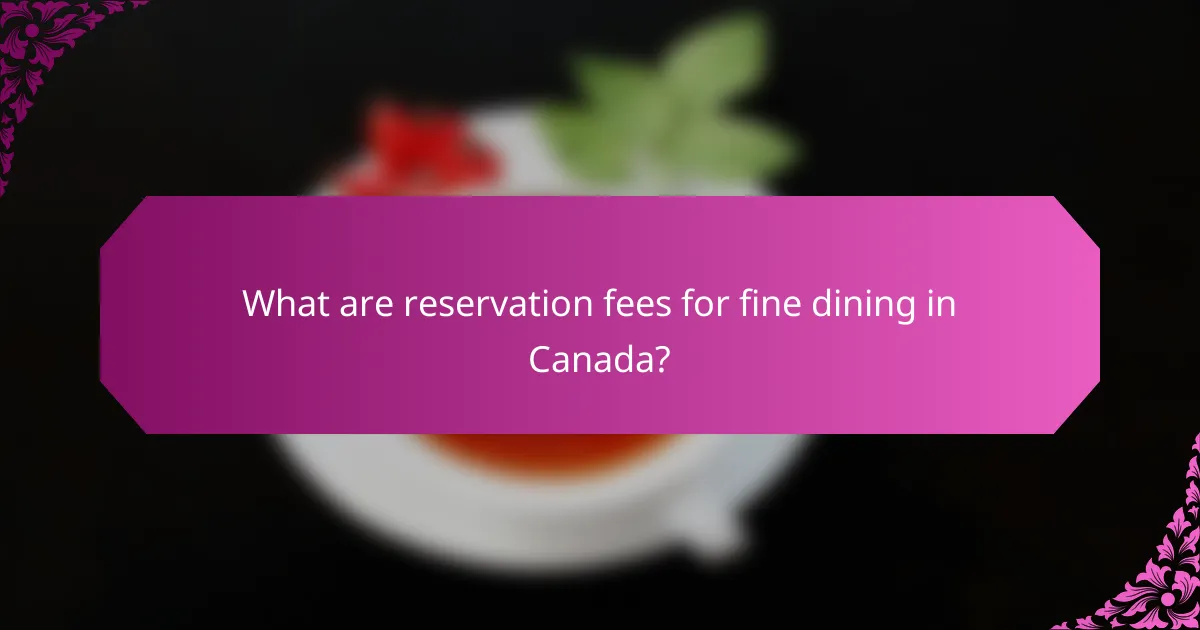Fine dining offers a unique culinary experience characterized by high-end ingredients and exceptional service, often found in Toronto’s vibrant restaurant scene. With premium ingredients that can significantly impact menu prices, diners can expect to pay more for the quality and creativity of their meals. Additionally, service charges ranging from 15% to 20% are typically added to the bill, reflecting the attentive hospitality that accompanies these luxurious dining experiences.

What are the best fine dining restaurants in Toronto?
Toronto boasts a vibrant fine dining scene, featuring a range of high-end restaurants that emphasize exquisite ingredients and exceptional service. Some of the best options combine innovative cuisine with a luxurious atmosphere, making them ideal for special occasions.
Top-rated fine dining venues
Among the top-rated fine dining venues in Toronto are places like Alo and Canoe, known for their creative menus and impeccable service. These restaurants often feature seasonal ingredients and offer tasting menus that showcase the chef’s artistry.
Reservations at these establishments can be competitive, so it’s advisable to book well in advance, especially for weekends and holidays. Expect to pay a premium for the experience, with average meal prices ranging from CAD 100 to CAD 300 per person, depending on the menu and wine pairings.
Michelin-starred options
Toronto has gained recognition for its Michelin-starred restaurants, including Alo and Sushi Masaki Saito. These venues are celebrated for their culinary excellence and commitment to quality, often providing unique dining experiences that reflect both local and international influences.
Dining at a Michelin-starred restaurant typically involves a higher price point, with tasting menus often exceeding CAD 200 per person. It’s essential to check for reservation policies, as many of these restaurants require bookings well in advance.
Local favorites
Local favorites like Buca and Scaramouche offer a blend of fine dining with a more casual atmosphere, making them popular among residents. These restaurants focus on high-quality ingredients while providing a welcoming environment that encourages diners to relax and enjoy their meals.
Prices at these establishments can vary, generally ranging from CAD 50 to CAD 150 per person. It’s wise to explore their menus online beforehand to find dishes that suit your taste and budget.

How much do high-end ingredients cost in fine dining?
High-end ingredients in fine dining can vary significantly in cost, often ranging from moderate to very expensive depending on the type and sourcing. Chefs select these premium items to enhance the dining experience, which can lead to higher menu prices and overall dining costs.
Price ranges for premium ingredients
Premium ingredients can range from around $20 to several hundred dollars per serving, depending on their rarity and quality. For instance, truffles may cost between $100 to $3,000 per kilogram, while high-quality Wagyu beef can range from $50 to over $300 per pound.
When dining at upscale restaurants, expect to pay a premium not only for the ingredients but also for the expertise in preparation and presentation. This often results in a total meal cost that can exceed a few hundred dollars per person, especially when paired with fine wines.
Examples of high-end ingredients
Some common high-end ingredients include caviar, saffron, and foie gras. Caviar, particularly Beluga or Osetra, can cost upwards of $200 per ounce, making it a luxurious addition to any dish. Saffron, known for its unique flavor and vibrant color, typically ranges from $10 to $30 per gram.
Other notable examples are organic heirloom vegetables, which may be sourced from specialty farms and can be priced significantly higher than standard varieties. These ingredients not only elevate the dish’s flavor but also contribute to the overall dining experience, justifying their higher price tags.

What are typical service charges in fine dining?
In fine dining, service charges typically range from 15% to 20% of the total bill. These charges are added to cover the cost of service provided by the staff, ensuring a high level of hospitality and attention to detail.
Standard service charge percentages
Most fine dining establishments automatically include a service charge of around 18% on the final bill. However, this percentage can vary by region and restaurant, with some places opting for a lower or higher rate. It’s advisable to check the menu or ask the staff if you’re unsure about the service charge policy.
Factors influencing service charges
Several factors can influence the service charge in fine dining, including the restaurant’s location, the level of service provided, and the type of cuisine. For instance, high-end restaurants in major cities may charge more due to higher operational costs and expectations for exceptional service.
Additionally, special occasions, such as private dining events or large parties, may incur different service charge rates. It’s important to communicate with the restaurant in advance to understand any specific policies that may apply to your reservation.

What are reservation fees for fine dining in Canada?
Reservation fees in fine dining establishments in Canada are charges applied to secure a table, often used to deter no-shows and ensure commitment from diners. These fees can vary widely depending on the restaurant’s prestige and demand, typically ranging from CAD 20 to CAD 100 or more.
Common reservation fee structures
Many fine dining restaurants employ a few standard structures for reservation fees. Some charge a flat fee per person, while others may require a percentage of the total expected bill. In certain cases, the fee may be fully or partially applied to the final bill if the reservation is honored.
It’s essential to check the restaurant’s policy regarding reservation fees, as some may have specific conditions, such as requiring a minimum number of guests or a cancellation notice period. Understanding these details can help avoid unexpected charges.
Examples of restaurants with reservation fees
Several high-end restaurants in Canada implement reservation fees. For instance, a renowned establishment in Toronto may charge CAD 50 per person for a prime time slot, which is credited towards the meal if attended. Another example is a popular Vancouver restaurant that requires a CAD 100 deposit for special tasting menus.
When considering dining at such venues, it’s advisable to review their reservation policies online or call ahead to clarify any fees. This ensures a smooth experience and helps manage expectations regarding costs.

How do fine dining service standards differ?
Fine dining service standards are characterized by a high level of attentiveness, professionalism, and personalization, setting them apart from casual dining experiences. These standards encompass everything from the way staff interact with guests to the meticulous attention given to food presentation and ambiance.
Comparison of service styles
In fine dining, service is often formal and structured, with a focus on creating a luxurious experience. This may include multiple courses served in a specific order, with each dish presented with detailed descriptions. In contrast, casual dining typically features a more relaxed atmosphere, where service is friendly but less formal, often allowing for greater guest interaction and flexibility in ordering.
Another key difference is the level of staff involvement. Fine dining establishments often employ a team of specialized staff, such as sommeliers and maitre d’s, who enhance the dining experience through their expertise. Casual dining usually has a single server handling multiple tables, which can lead to a more laid-back but less personalized service.
Training and expectations for staff
Staff in fine dining restaurants undergo extensive training to meet high service expectations, including knowledge of food and wine pairings, etiquette, and customer service skills. This training often includes role-playing scenarios to prepare staff for various guest interactions and to ensure consistency in service delivery.
Expectations for fine dining staff are significantly higher than in casual settings. Employees are expected to anticipate guest needs, provide personalized recommendations, and maintain a polished appearance. This level of professionalism is crucial in creating an exceptional dining experience that justifies the higher price point associated with fine dining establishments.

What are the trends in fine dining experiences?
Fine dining experiences are increasingly characterized by a focus on high-quality ingredients, personalized service, and unique culinary concepts. These trends reflect a shift towards more immersive and memorable dining, where the overall experience is as important as the food itself.
Emerging culinary trends
Emerging culinary trends in fine dining often emphasize sustainability and local sourcing. Many restaurants are now prioritizing farm-to-table practices, offering seasonal menus that highlight regional ingredients. This not only supports local farmers but also enhances the freshness and flavor of the dishes.
Another notable trend is the incorporation of global flavors and techniques. Chefs are experimenting with fusion cuisine, blending traditional recipes with contemporary cooking styles from various cultures. This approach creates innovative dishes that surprise and delight diners.
Innovative dining concepts
Innovative dining concepts are reshaping the fine dining landscape by introducing unique themes and interactive experiences. For instance, some restaurants now offer chef’s table experiences, where guests can watch their meals being prepared in an intimate setting. This not only enhances the dining experience but also fosters a connection between the chef and the diners.
Additionally, many establishments are embracing technology to elevate service. From digital menus to augmented reality experiences, these advancements can streamline the dining process and provide guests with engaging content about their meals. However, it’s essential to balance technology with personal touch to maintain the warmth of fine dining.

How is fine dining adapting to consumer preferences?
Fine dining is increasingly aligning with consumer preferences by emphasizing sustainability and personalized experiences. These adaptations reflect a growing demand for ethical dining practices and tailored services that enhance the overall dining experience.
Focus on sustainability
Many fine dining establishments are prioritizing sustainability by sourcing local, organic ingredients and minimizing waste. This approach not only supports local economies but also appeals to environmentally conscious consumers who value eco-friendly practices.
Restaurants often implement measures such as seasonal menus that highlight fresh produce, reducing carbon footprints associated with transportation. Additionally, some establishments are adopting zero-waste policies, where every part of an ingredient is utilized, further enhancing their sustainability credentials.
Personalized dining experiences
Fine dining is shifting towards more personalized experiences to cater to individual preferences and dietary needs. This can include customized menus, special requests, and even unique dining settings that enhance the guest’s experience.
For example, some restaurants offer tasting menus that can be tailored to guests’ specific tastes or restrictions, allowing for a more intimate and memorable meal. Additionally, advanced reservation systems enable diners to communicate their preferences in advance, ensuring a seamless and personalized service upon arrival.

What is the future of fine dining in Canada?
The future of fine dining in Canada is likely to evolve with a focus on sustainability, local sourcing, and enhanced dining experiences. As consumer preferences shift, restaurants may prioritize high-quality ingredients and innovative service models to attract discerning diners.
High-end ingredients
High-end ingredients are essential in fine dining, often sourced from local farms or specialty suppliers. Canadian chefs are increasingly using seasonal produce, artisanal meats, and sustainable seafood to create unique dishes that reflect the region’s culinary heritage.
For example, ingredients like Alberta beef, Nova Scotia lobster, and British Columbia salmon are frequently featured in upscale menus. Diners can expect to see a rise in plant-based options that highlight local vegetables and grains, catering to diverse dietary preferences.
Service charges
Service charges in fine dining establishments can vary significantly, often ranging from 15% to 20% of the total bill. Some restaurants may include a service charge automatically, while others leave it to the discretion of the customer.
It’s important for diners to understand the service model of each restaurant. In Canada, tipping practices are generally expected, but the inclusion of service charges can simplify the payment process and ensure fair compensation for staff.
Reservation fees
Reservation fees are becoming more common in fine dining as restaurants seek to manage demand and reduce no-shows. These fees can range from a nominal amount to a percentage of the expected meal cost, often credited towards the final bill.
When making a reservation, diners should be aware of any fees associated with their booking. This practice helps restaurants maintain their operations while ensuring that committed diners have a guaranteed spot for their dining experience.


